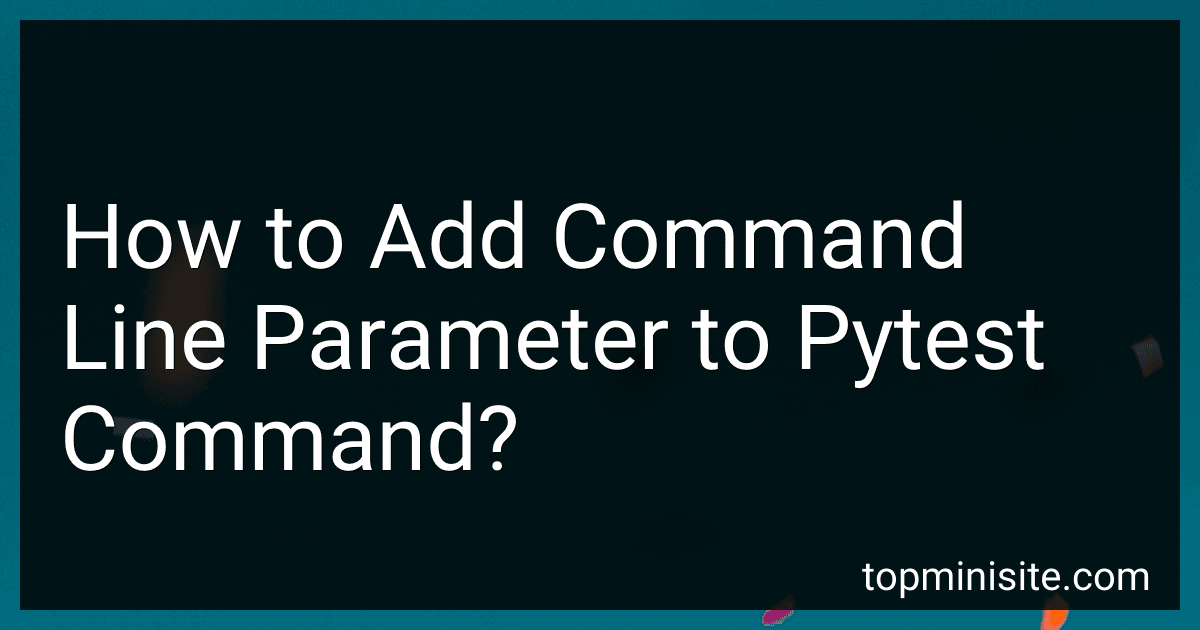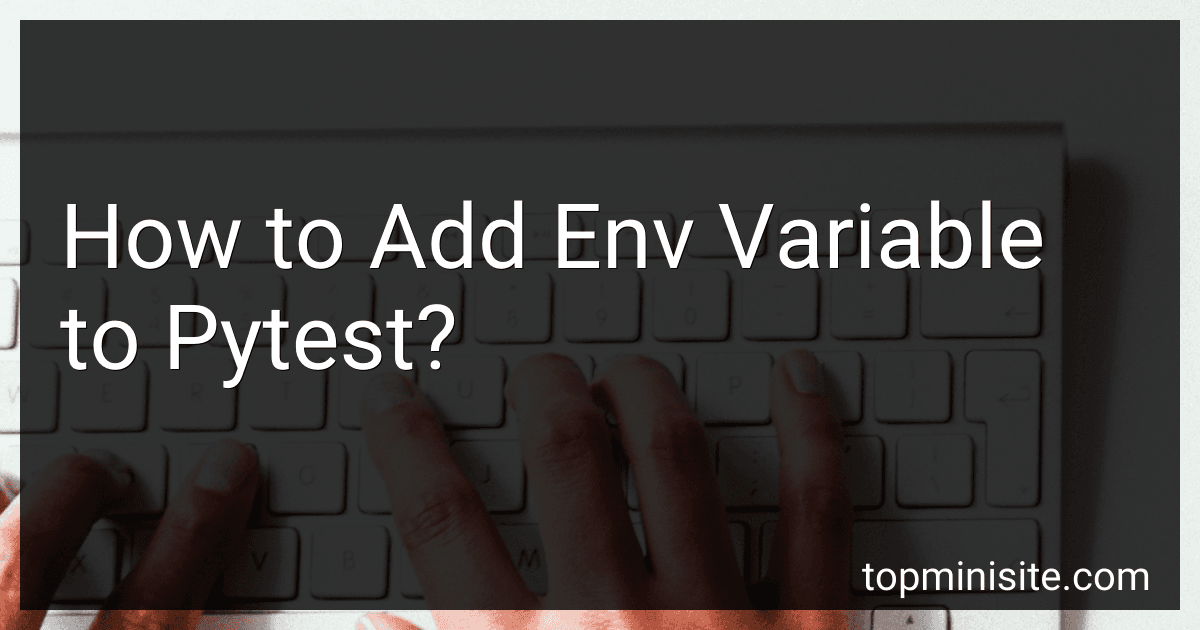Posts (page 39)
-
 6 min readTo build a wrapper pytest plugin, you need to create a Python module containing the necessary code for enhancing the functionality of pytest. This module should define hooks, fixtures, and any other custom features you want to add to pytest.Start by creating a Python file with a unique name, such as my_pytest_plugin.py. Within this file, define the necessary functions and classes that interact with the pytest framework.
6 min readTo build a wrapper pytest plugin, you need to create a Python module containing the necessary code for enhancing the functionality of pytest. This module should define hooks, fixtures, and any other custom features you want to add to pytest.Start by creating a Python file with a unique name, such as my_pytest_plugin.py. Within this file, define the necessary functions and classes that interact with the pytest framework.
-
 7 min readA stale element exception occurs when an element on a web page has changed or become outdated, making it difficult for the test to find and interact with that element. To work around this issue in pytest, you can try the following strategies:Using try-except blocks: Wrap the code that interacts with the element in a try-except block. In the except block, you can add a wait mechanism to retry finding the element or refresh the page before trying again.
7 min readA stale element exception occurs when an element on a web page has changed or become outdated, making it difficult for the test to find and interact with that element. To work around this issue in pytest, you can try the following strategies:Using try-except blocks: Wrap the code that interacts with the element in a try-except block. In the except block, you can add a wait mechanism to retry finding the element or refresh the page before trying again.
-
 3 min readTo disable pytest fixtures, you can use the autouse parameter in the fixture declaration. By setting autouse=False, the fixture will not be automatically applied to every test function. Instead, you can manually include the fixture in specific test functions as needed. You can also use the @pytest.mark.parametrize decorator to selectively apply a fixture to certain tests. This allows for more control over when and where fixtures are used in your test suite. Additionally, you can use the @pytest.
3 min readTo disable pytest fixtures, you can use the autouse parameter in the fixture declaration. By setting autouse=False, the fixture will not be automatically applied to every test function. Instead, you can manually include the fixture in specific test functions as needed. You can also use the @pytest.mark.parametrize decorator to selectively apply a fixture to certain tests. This allows for more control over when and where fixtures are used in your test suite. Additionally, you can use the @pytest.
-
 3 min readTo run pytest on a Python script from stdin, you can use the following command:pytest -This command will read the Python script from the standard input and run the tests defined in the script. Alternatively, you can also pipe the script into the pytest command, like this:cat script.py | pytest -This method allows you to run pytest on a Python script without saving the script to a file first.
3 min readTo run pytest on a Python script from stdin, you can use the following command:pytest -This command will read the Python script from the standard input and run the tests defined in the script. Alternatively, you can also pipe the script into the pytest command, like this:cat script.py | pytest -This method allows you to run pytest on a Python script without saving the script to a file first.
-
 6 min readTo patch an object method in pytest, you can use the unittest.mock.patch decorator. This decorator allows you to temporarily replace the specified method with a mock object during the test execution. You can specify the object method to patch as an argument to the patch decorator.For example, if you have a class MyClass with a method my_method, you can patch my_method using the patch decorator like this: from unittest.
6 min readTo patch an object method in pytest, you can use the unittest.mock.patch decorator. This decorator allows you to temporarily replace the specified method with a mock object during the test execution. You can specify the object method to patch as an argument to the patch decorator.For example, if you have a class MyClass with a method my_method, you can patch my_method using the patch decorator like this: from unittest.
-
 4 min readTo add command line parameters to a pytest command, you can simply include them when running the pytest command in the terminal. For example, you can add parameters such as the test file or directory to run, markers to select specific tests, verbosity level, and more. These parameters can help customize how pytest runs and what tests are included in the test execution. By including command line parameters, you can easily modify the behavior of pytest according to your specific testing needs.
4 min readTo add command line parameters to a pytest command, you can simply include them when running the pytest command in the terminal. For example, you can add parameters such as the test file or directory to run, markers to select specific tests, verbosity level, and more. These parameters can help customize how pytest runs and what tests are included in the test execution. By including command line parameters, you can easily modify the behavior of pytest according to your specific testing needs.
-
 6 min readWhen running pytest, temporary files are often generated as part of the testing process. To automatically delete these temporary files after the tests have completed, you can utilize built-in pytest fixtures such as tmpdir or tmp_path. These fixtures provide a convenient way to create temporary directories or files during testing, and they are automatically cleaned up at the end of the test run.
6 min readWhen running pytest, temporary files are often generated as part of the testing process. To automatically delete these temporary files after the tests have completed, you can utilize built-in pytest fixtures such as tmpdir or tmp_path. These fixtures provide a convenient way to create temporary directories or files during testing, and they are automatically cleaned up at the end of the test run.
-
 6 min readIn order to add an environment variable to pytest, you can use the pytest command followed by the --env flag and the name of the environment variable you want to set. For example, to add an environment variable named MY_ENV_VAR with a value of testing, you can run pytest --env MY_ENV_VAR=testing. This will make the environment variable available to your pytest tests during execution.[rating:b1c44d88-9206-437e-9aff-ba3e2c424e8f]How to store environment variables securely in pytest.
6 min readIn order to add an environment variable to pytest, you can use the pytest command followed by the --env flag and the name of the environment variable you want to set. For example, to add an environment variable named MY_ENV_VAR with a value of testing, you can run pytest --env MY_ENV_VAR=testing. This will make the environment variable available to your pytest tests during execution.[rating:b1c44d88-9206-437e-9aff-ba3e2c424e8f]How to store environment variables securely in pytest.
-
 5 min readTo get rid of pytest warnings, you can try the following approaches:Upgrade pytest to the latest version to ensure compatibility with your code and dependencies.Check for any warnings in your test cases or test fixtures and update them accordingly.Use the "--disable-warnings" flag when running pytest to suppress all warning messages.Look for deprecated functions or outdated syntax in your test code and update them to the latest version.
5 min readTo get rid of pytest warnings, you can try the following approaches:Upgrade pytest to the latest version to ensure compatibility with your code and dependencies.Check for any warnings in your test cases or test fixtures and update them accordingly.Use the "--disable-warnings" flag when running pytest to suppress all warning messages.Look for deprecated functions or outdated syntax in your test code and update them to the latest version.
-
 5 min readTo capture print statements inside pytest hooks, you can use the capsys fixture provided by pytest. This fixture captures the stdout and stderr streams from the test function and allows you to access them for inspection.You can use the capsys.readouterr() method to capture the captured output as a tuple of stdout and stderr strings. This allows you to assert on the printed output within your test function.
5 min readTo capture print statements inside pytest hooks, you can use the capsys fixture provided by pytest. This fixture captures the stdout and stderr streams from the test function and allows you to access them for inspection.You can use the capsys.readouterr() method to capture the captured output as a tuple of stdout and stderr strings. This allows you to assert on the printed output within your test function.
-
 5 min readIn pytest, you can skip tests based on a condition by using the skipif decorator. This decorator takes a condition as an argument and skips the test if the condition evaluates to True. You can use any valid Python expression as the condition.For example, if you only want to run a test on certain operating systems, you can use the platform module to check the current operating system and skip the test if it doesn't match: import platform import pytest @pytest.mark.skipif(platform.system() .
5 min readIn pytest, you can skip tests based on a condition by using the skipif decorator. This decorator takes a condition as an argument and skips the test if the condition evaluates to True. You can use any valid Python expression as the condition.For example, if you only want to run a test on certain operating systems, you can use the platform module to check the current operating system and skip the test if it doesn't match: import platform import pytest @pytest.mark.skipif(platform.system() .
-
 6 min readIn pytest, tests can be executed from inside a class by using the pytest.mark.parametrize decorator to mark the test function with specific parameters. This allows for multiple test cases to be run using the same test function. Additionally, test functions within a class can be marked with the @pytest.mark.parametrize decorator to run multiple test cases with different parameters. Finally, the pytest fixture decorator can be used to set up and tear down any necessary resources for the test.
6 min readIn pytest, tests can be executed from inside a class by using the pytest.mark.parametrize decorator to mark the test function with specific parameters. This allows for multiple test cases to be run using the same test function. Additionally, test functions within a class can be marked with the @pytest.mark.parametrize decorator to run multiple test cases with different parameters. Finally, the pytest fixture decorator can be used to set up and tear down any necessary resources for the test.